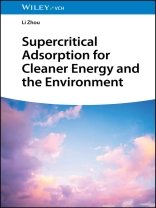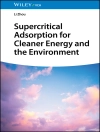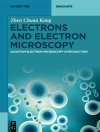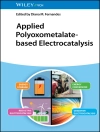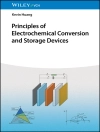Comprehensive and technically detailed approach to addressing environmental and energy challenges through the advance of adsorption theory and techniques
Supercritical Adsorption for Cleaner Energy and the Environment delves into the novel theory of supercritical adsorption and its practical applications in energy and environmental management issues. The book addresses critical topics such as supercritical adsorption and sustainable energy solutions, provides a deep understanding of advanced theories and techniques of supercritical adsorption, and addresses innovative methods for fuel desulfurization, natural gas storage, hydrogen energy, and emission-free coal power generation in the energy industry.
The book is divided into two parts. The first part provides a comprehensive theory of supercritical adsorption, illustrated with examples that showcase significant progress in both applied and theoretical research due to recent advancements. Building on this theoretical foundation, the second part demonstrates how supercritical adsorption theory can address research questions in the fields of energy and environmental science.
Supercritical Adsorption for Cleaner Energy and the Environment includes information on:
- Solutions for theoretical problems of supercritical adsorption, such as determination of absolute adsorption and the volume or density of the adsorbed phase
- Adsorptive technology to enhance natural gas storage, and methane enrichment from low-quality gas
- Ideas, chemical reactions, and materials and adsorbents used in supercritical adsorption research with the potential to transform approaches in environmental challenges
- Efficient and feasible strategies for achieving carbon circulation within the energy consumption and generation cycle
Supercritical Adsorption for Cleaner Energy and the Environment is an essential forward-thinking reference for practitioners and researchers in the fields of chemistry, chemical engineering, energy, and environmental science.
Table of Content
Preface xi
Part I Progress in Adsorption 1
1 Classic Adsorption Theory 3
1.1 Adsorption Definition 3
1.2 Type of Adsorption Isotherms 5
1.3 Henry Law 6
1.4 Langmuir Equation of Monolayer Adsorption 7
1.5 BET Equation of Multilayer Adsorption 9
1.5.1 Interpretation of BET Equation for Type-II and Type-III Isotherms 11
1.5.2 Limitations of the BET Equation 12
1.6 Potential Equations of Multilayer Adsorption 13
1.7 Kelvin Equation of Capillary Condensation 17
1.7.1 Notes on Kelvin Equation 18
References 20
2 Acquisition of Supercritical Adsorption Isotherms 21
2.1 Volumetric Method 21
2.2 Gravimetric Method 23
2.3 Other Measurement Techniques 23
2.4 Principal Factors Affecting Adsorption Measurements 24
2.5 Compressibility Factor and Fugacity Coefficient 25
2.6 Cryostat 28
2.7 Illustration of Calculations 29
2.7.1 Compressibility Factor and Fugacity Coefficient 29
2.7.1.1 By SRK Equation 29
2.7.1.2 By BWR Equation 30
2.7.1.3 Based on Experimental P-V-T Data 31
2.7.1.4 A Comment 32
2.7.2 Calibration of Adsorbent 33
2.8 Generating Adsorption Isotherms by Molecular Simulation 37
References 38
3 Collection of Supercritical Adsorption Isotherms 41
3.1 Adsorption of H2 on Activated Carbon 41
3.2 Adsorption of CH4 on Activated Carbon 41
3.3 Adsorption of N2 on Silica Gel over a Large Temperature Range 43
3.4 Adsorption of O2 on Activated Carbon 46
3.5 Adsorption of CH4 and N2 on Activated Carbon and Silica Gel 47
3.6 Adsorption of CO2 on Activated Carbon for Near-Critical Region 50
3.7 Adsorption of H2, N2, O2, CH4, and CO2 on Carbon Molecular Sieves 52
3.8 Adsorption of CO2, CH4 , and N2 on Silica Molecular Sieves 54
3.9 Adsorption of H2 on Carbon Nanotubes 56
3.10 Adsorption of Hydrogen Isotopes on Micro- and Mesoporous Adsorbents with Orderly Structure 57
References 60
4 Theoretical Basis of Supercritical Adsorption 63
4.1 Isotherm Types of Supercritical Adsorption 63
4.2 Theory Crux of Supercritical Adsorption 63
4.3 Evaluation of the Henry Law Constant from Experimental Isotherms 64
4.3.1 Based on Langmuir Equation 64
4.3.2 Based on Virial Equation 65
4.3.3 Evaluation of Adsorption Heat 66
4.4 Determination of Absolute Adsorption 69
4.5 Evaluation of Volume or Density for the Adsorbed Phase 73
4.6 Isotherm Modelling 76
4.7 Adsorption Mechanism at Supercritical Temperature 77
4.8 Boundary of Supercritical Adsorption 80
4.9 Effect of Supercritical Adsorption Theory 82
4.9.1 Effects on Applied Research 82
4.9.2 Effect on Theoretical Research 83
4.9.2.1 Experimental 84
4.9.2.2 Description of the Adsorbed Phase 86
4.9.2.3 Presented Model for the Prediction of Multicomponent Adsorption 87
4.9.2.4 Verification of the New Model 90
4.9.2.5 Conclusion of Comparisons 96
References 98
Part II Effect of Adsorption Progress on Energy and Environment 103
5 Carbon Reduction Makes Coal Power Emission-Free 105
5.1 Present State of Coal-Fired Power Plants 105
5.2 Theoretical Basis of the Zero-Emission Approach 107
5.3 Experimental Basis of the Zero-Emission Approach 109
5.3.1 Experiments for Absence of Water in SFG 110
5.3.2 Experiments with Presence of Water in SFG 112
5.4 Process to Realize Zero-Emission Power Plant 113
5.5 Concluding Remarks 115
References 115
6 Adsorption/Reaction Compound Function Removes Sulfur from Oil Fuels 117
6.1 Introduction 117
6.2 Theoretical Basis 118
6.3 Experimental Study 120
6.3.1 Adsorbent, Catalyst, and Testing Fuels 120
6.3.2 Reagent Quality and Inspection Method 121
6.3.3 Performance Test 121
6.3.4 Additional Tests 122
6.3.4.1 Regeneration 122
6.3.4.2 Test on Commercial Fuels 122
6.3.4.3 Tests on Corrosion 122
6.3.5 Results and Discussion 122
6.3.5.1 Quasi-first-order Dynamics of the Nanoreaction 122
6.3.5.2 Effect of Temperature 124
6.3.5.3 Effect of Adsorbent and Nanoreactor Dimension 124
6.3.5.4 Compatibility of Desulfur Function with Fuel Type 127
6.3.5.5 Desulfur Performance on Commercial Fuels 127
6.3.5.6 Regeneration and Corrosion Test 128
6.3.5.7 Discussion 129
6.3.5.8 Conclusion 131
References 131
7 Adsorptive Approaches for Methane-majored Fuels 135
7.1 Adsorbed Natural Gas Limited by Adsorption Mechanism 135
7.2 Enhanced Storage of Natural Gas in Wet Adsorbents 137
7.3 Charging/Discharging Experiments of Wet Storage 138
7.3.1 Influence of Charging Pressure and Packing Density of Wet Carbon on Released Amount 139
7.3.2 Analysis and Discussion of Hydrate Formation in Wet Activated Carbon 141
7.3.3 Feature of Charging Process 143
7.3.4 Feature of Discharging Process 144
7.4 Effect of Pore Size Distribution on Storage Capacity of Wet Activated Carbon 145
7.4.1 Conceptional and Experimental Development of Activated Carbon 146
7.4.2 Storage Capacity 147
7.4.3 Results and Discussion 148
7.4.3.1 Porous Structure of the Activated Carbon 148
7.4.3.2 Gravimetric Storage Capacity 149
7.4.3.3 Volumetric Storage Capacity 151
7.4.3.4 Conclusion 152
7.5 Removal of Trace H2S from Natural Gas 152
7.5.1 General Status of the Issue 152
7.5.2 Performance of Solvent-coated Adsorbents 153
7.5.2.1 The Sorbent 153
7.5.2.2 The Testing Process 155
7.5.2.3 The Sorption Pressure 156
7.5.2.4 The Purging Ratio 157
7.5.2.5 Time Allocation in an Operation Cycle 158
7.5.2.6 Conclusion 162
7.6 Enrichment of Methane from Impoverished Gas 163
7.6.1 Separating CH4 /N2 Mixture by Adsorption 163
7.6.1.1 Experimental 164
7.6.1.2 Evaluation of Separation Coefficient 165
7.6.1.3 Results and Discussion 166
7.6.2 Enrichment of Methane by PSA Complemented with CO2 Displacement 170
7.6.2.1 Experimental Apparatus 171
7.6.2.2 Experimental Material 172
7.6.2.3 Experimental Procedure 174
7.6.2.4 Performance Evaluation 175
7.6.2.5 Enrichment Without CO2 Displacement 176
7.6.2.6 Enrichment with CO2 Displacement 177
7.6.2.7 Selection of Adsorption Time 178
7.6.2.8 Relationship Between Product Concentration and Methane Recovery 179
7.6.2.9 Effect of Feed Gas Concentration on Enrichment 180
7.6.2.10 Studies on Adsorbent Regeneration 182
7.6.2.11 Test on Consecutive Cycling 184
7.6.2.12 Comparison with Literature 184
7.6.2.13 Conclusion 184
References 185
8 Studies on Hydrogen Energy 191
8.1 Introduction 191
8.2 Recovery of Hydrogen from Process Flue Gas 192
8.2.1 Experimental Apparatus 192
8.2.2 Measurement of Adsorption Isotherms and Breakthrough Curves 194
8.2.3 Studies on the Function of Buffer Tanks 196
8.2.4 Study on Cycling Sequence of the New 4-bed PSA Process 200
8.2.5 Studies on Separation Performance at Low Operation Pressure 202
8.2.5.1 Based on Adsorbents of OAC+ZMS-5A 202
8.2.5.2 Based on Adsorbents of SAC+ZMS-5A 202
8.2.5.3 Comparison Between Two Adsorbent Combinations 203
8.2.6 Studies on Effect of Purging Ratio 203
8.2.7 Studies on Operation Stability and Flexibility of the New PSA Process 206
8.3 Routine Technology of Hydrogen Production 207
8.4 Decomposition of Water Through Redox Reactions Looping 209
8.4.1 Theoretical Basis 209
8.4.2 Experimental Proof 210
8.4.2.1 Oxidation/Reduction Cycling 210
8.4.2.2 Test on Catalytic Carbonization of Coal 213
8.4.2.3 Test on Coupling Redox Cycle with Charcoal Gasification 215
8.4.2.4 Comparison with Counterpart Processes 216
8.4.2.5 Conclusion 218
8.5 Hydrogen Storage 218
8.5.1 Hydrogen Storage by Cryogenic Adsorption 218
8.5.1.1 Comparison of Compression Storage at 77 K and 298 K 219
8.5.1.2 Storage of H2 on Activated Carbon Cooled by Liquid Nitrogen 219
8.5.2 Other Studies on Hydrogen Storage 223
8.5.2.1 Liquefaction 223
8.5.2.2 Metallic Hydrides 223
8.5.2.3 Complex Hydrides 224
8.5.2.4 Other Ideas About Hydrogen Storage 224
References 225
Epilogue 231
Acknowledgments 235
Index 237
About the author
Li Zhou was previously Professor working in the School of Chemical Engineering at Tianjin University, China. He retired from this University in 2009. He served as Director Board Member of the International Adsorption Society from 2004-2010.
